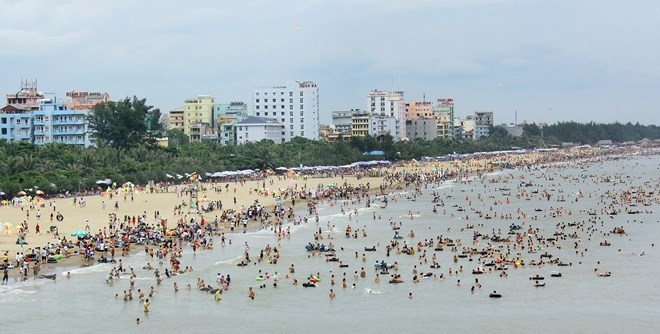
Bestowed with gorgeous natural landscapes and a diverse cultural space, the northern central province of Thanh Hoa has huge potential to branch out a wide range of tourism products, however, it faces calls for reform towards sustainable tourism development.

Sam Son beach
is a renowned tourist attraction in Thanh Hoa province. (Photo: VNA)
At a conference held in the
locality, on June 19, experts recommended that excellent tourism products must
have a close connection with the local people and culture, while calling for
more investment projects in tourism infrastructure.
Along with improving the efficiency
of investment promotion campaigns to lure businesses with financial strengths
to invest in strategic and high-end projects, it is necessary for the province
to develop standout tourism packages in conjunction with protecting natural
sceneries.
Furthermore, the province was
advised to join hands with Hanoi, Ho Chi Minh City, the
eight northwestern provinces, the northern coastal provinces and the northern
central coastal localities to study and build common inter-regional tourism
products, they added.
Lauding the suggestions of the
experts, Vice Director of the provincial Department of Culture, Sports and
Tourism Vuong Thi Hai Yen expressed her hope that the province’s tourism sector
would be accompanied by enterprises and media agencies in the near future.
The department will recommend
solutions to the provincial People’s Committee to popularise tourist
attractions, lure visitors and connect local tourism spots to create a
breakthrough for the non-smoke sector, promptly turning Thanh Hoa into a
national and international tourism hub, she said.
Last year, the province welcomed 7
million arrivals and earned VND 8 trillion (US$ 352 million) from tourism
services, up 11.5 percent from the same time last year. The locality targets to
serve 8.2 million visitors in 2018 and is eying VND 10.6 trillion (US$ 466.4
million) in tourism revenue.
Many renowned enterprises such as FLC and Sun
Group have poured capital into the local tourism sector. During 2015-2017, 18
tourism infrastructure projects were carried out, while investment licenses
were granted for 61 tourism projects with total registered capital of nearly
VND 62.5 trillion (US$ 2.75 billion).
Source: NDO
A diverse chain of eco-tourism and resort destinations concentrated in Hoa Binh city and the districts of Tan Lac, Da Bac, and Luong Son… Along with the launch of several key high-quality resort tourism projects, these developments have reshaped the landscape and enhanced the appeal of Hoa Binh as a travel destination.
Boasting diverse terrain, a mild climate, and rich natural resources, Cao Phong district is increasingly asserting its place on Vietnam’s tourism map, attracting both domestic and foreign visitors. The district is renowned for its stunning landscapes, majestic mountains, a crystal-clear hydropower lake, and the unique cultural identity of local ethnic groups.
With its pristine landscapes, unique cultural heritage of Muong ethnic minority, and an expanding range of visitor experiences, Tan Lac district of Hoa Binh has fast become a captivating destination for both domestic and international tourists.
Until now, Sung village in Cao Son commune, Da Bac district remains the only Dao ethnic community in Hoa Binh province to develop a community-based tourism model. Beyond its untouched natural landscapes, cultural identity serves as the cornerstone attraction for visitors.
Alongside the diverse cultural identities of the Kinh, Muong, Tay, Thai, Dao, and Mong ethnic people, Hoa Binh province is also renowned as the "capital" of the northwestern Vietnamese cuisine, offering unique and distinctive dishes. At festivals, during Lunar New Year (Tet), or on significant family or community occasions, special dishes are prepared, leaving a lasting impression on visitors.
A Phong Linh (Yellow Tabebuia) flower garden in Thang village, Thach Yen commune, Cao Phong district is currently in full bloom, drawing a large number of visitors.



